Gossamer Gear The One
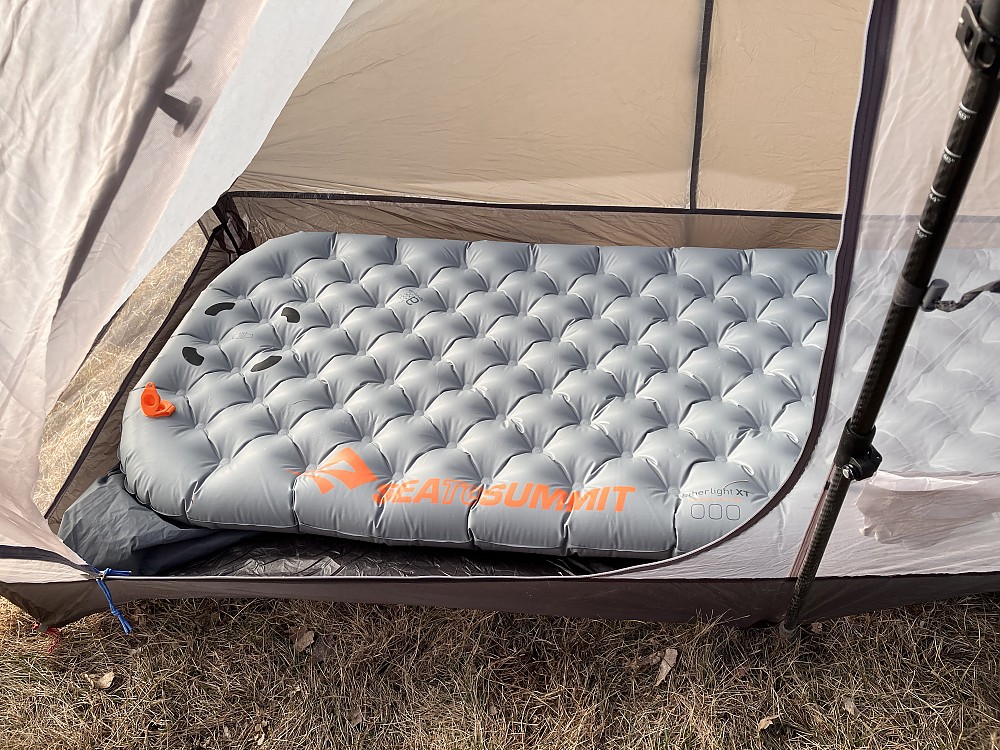
"The One" is an ultralight 1P shelter meant for backpackers and bikepackers. It packs down small, requires two trekking poles, and is an excellent choice for most people looking for this type of shelter. However, it is not ideal for taller people.
Pros
- Ultralight (18 ounces!)
- Packs down small
- Easy to set up
- Much headroom
- Reasonably priced
Cons
- Only one door/vestibule
- Not great for tall people
- Small-ish door
I realize there are tons of online reviews for "The One" by Gossamer Gear. I'm writing this review as a brief one that mostly focuses on the interior size. I'll defer to other longer reviews for more details.

First, I do have to say "The One" is indeed light and packs up super small. It's only around 18 ounces and doesn't take up much space in my pack. This shelter is also pretty easy to set up once you get the hang of it. It has one door. The back of the tent has a short awning that covers a back panel that is partially mesh. The tent doesn't take up much space so it should fit in most tenting areas. It is set up with two trekking poles or two poles you can buy from Gossamer Gear. It is a single-wall tent and has the pros and cons of other single wall tents. Overall, this is a legit and very nice UL 1P shelter.

Second, let me talk about the interior space. I'm 6'1". I've tried other 1P shelters and they are often too small for me because my feet brush against the sides. I use a 3.5- or 4-inch pad and a down quilt. I have to say that this Gossamer Gear "The One" is also just a bit too short for me. The floor is 84 inches long which fits my 77-inch pad pretty well. But when I lay in this tent on my pad, my feet are about one inch from the side wall. That's not enough space especially when using a down quilt on damp or rainy nights.

A picture of the foot area of the interior. Note the guyline (pulled out from the outside of the tent). Also note the lack of extra space around my long/wide pad.
This tent does have head and feet guyout points. This means I can gain about 4 inches of clearance for my head and feet, which definately helps. But it doesn't quite help enough. If lie on my back and lift my feet at all, they rub the side.

Also, my mat (77x25 inches) does fit in this tent just fine. The floor dimensions are 84x33/21. This means there's not a lot of space left over for gear. I do store my pack in the vestibule, so that doesn't matter to me. But a large pad does really make for minimal extra gear space.
NOTE: the tent is wider inside at the top. This means you do have a TON of headroom, which is pretty cool. When I sit up even at 6'1" I don't feel cramped at all. However, the door is a bit narrower than I'd like and it's sometimes a chore for my tall self to get out. And I'm not even that old yet!
I could definately make this tent work if I had to, even with a large/wide pad. But in the rain it would mean I'd definitely rub against the sides and I'd get wet.
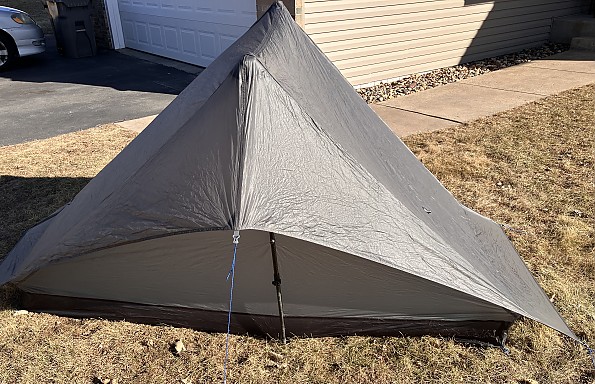
Here's a pic of the back of the tent - the awning covers a top area of mesh. Again, the wrinkles come out when you pitch it tighter.
All in all, this would be an ideal UL 1P tent for me if I was maybe 5'11" or under. I'd for sure keep it and love it! But I'm just too tall for it, sadly.
Background
I've been backpacking for many years and have tried out vairous 1P and 2P UL tents. I know what I like and don't like, and I know good features and not-so-good features. Though I'm not an expert at tents, I'm experienced enough to have something to say!
Source: bought it used
Price Paid: $175
The Gossamer Gear The One is a very straightforward non-free standing tent design that provides a nice amount of room, is lightweight, and is a reasonably priced shelter option for the solo hiker focused on minimizing weight.
Pros
- Lightweight
- Fast and easy setup
- Just the right amount of space and headroom
- Factory taped seams
- Small volume when packed
Cons
- The included stakes are just so-so…
- Could use more venting
Overview
Back in September of 2020 Gossamer Gear was phasing out the existing version of The One available as they were about to release an updated 2021 version of The One, and put the existing version on sale at a great price, so I picked one up.
I really didn’t need another solo shelter as I already own an MSR Carbon Reflex 1 and a Six Moon Designs Lunar Solo, but I’ve always liked the design of the Gossamer Gear The One and it had the potential to shave a few more ounces off my base weight, so I couldn’t see the harm in owning one more tent.
The Gossamer Gear The One is a non-freestanding, two-pole tent where you utilize your trekking poles to support the tent.

The Basics of What is Included
The Gossamer Gear The One tent comes packaged in its primary stuff sack as shown in the picture below.

Within the basic package you get the tent, stuff sack, guy lines that come pre-attached to the tent, six stakes, and a small stuff sack for the stakes.
To actually be able to use the Gossamer Gear The One you need to provide two trekking poles that are or can be adjusted to approximately 49 inches and six tent stakes (eight if you want to use the side pullouts and 12 if you also want to stake down the bathtub floor), and while not required, a good ground cloth/footprint is always a smart thing to use and I’ve been using a sheet of Polycryo with this tent.
The tent includes preinstalled reflective guy lines at each of the two trekking pole locations and at the four corners of the tent. Two additional guy lines are included that you can attach to the side pullout on the tent.
No setup instructions were included with the tent, but the process is pretty straightforward that you should be able to figure it out on your own. Gossamer does provide a nice video on how to set up the tent at the web page for The One here at this link:
Design and Construction
I have owned a number of tents over the years from manufacturers like North Face, Marmot, REI, Tarptent, MSR, and Six Moon Designs, but this is my first experience with a Gossamer product and I found the tent to be very well constructed with nice design details.
The One utilizes a bathtub floor made from a 10 Denier custom-formulated 10d high tenacity nylon blended with a silicone/polyurethane coating that is waterproof to at least 1200mm. The tent canopy is made from the same basic material, but in a lighter 7denier weight. All seams important for maintaining the waterproofness of the tent are factory taped.
If you are not familiar with waterproofness ratings, a 1200 mm rating means that the material will just start to allow water to pass through when it is subjected to the pressure of a one-inch square column of water, 1200 millimeters tall.
The following picture is of one corner of the bathtub floor and shows how the seams are taped seams and general constructions details .
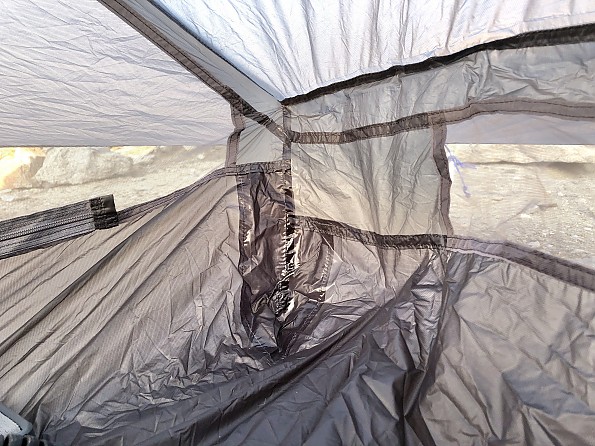
I’m not exactly sure what mesh is used, but it seems to be 20 Denier UL No-see-um netting.
The tent is supported by two trekking poles that lean slightly outward which provides greater head and shoulder room when you are sitting up compared to the width of the floor. This is a nice design touch as it helps make The One feel a bit more roomy which can be an issue with some single-person tents.
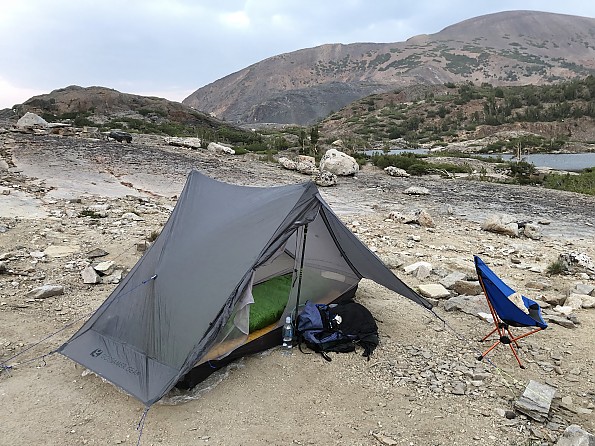
The trekking pole is installed handle side up which fits into a pocket at the crest of the tent and the pointy end goes into a grommet that is on a tab attached to the floor as shown in the pictures below.


For the basic setup the four corners of the tent are staked out using preinstalled tensioners and reflective cord. The corners where the lines are attached to the tent are also nicely reinforced as shown in the picture below.

The stakes included with The One are a pretty basic design as shown in the picture below. While light, they are just adequate for getting the job done and it would be wise to pick up to more substantial stakes to use with the guy lines that anchor the two trekking poles.

My experience actually using the Gossamer The One
The Gossamer The One is a pretty basic tent that I found quick and easy to set up and that had more than enough space for me and my gear.
I currently use a large Therm-a-rest NeoAir Xlite mattress that is 77 inches long by 25 inches wide and 2.5 inches thick, which is one of the bigger mattresses available. The floor of The One, which is 88 inches long by 36 inches wide at the head end and 24 inches at the foot, easily accommodated my mattress and still left me with plenty of space along the sides of the mattress to store the things I normally keep in my tent with me.
Here are a couple of pictures to give you a perspective of the floor space.

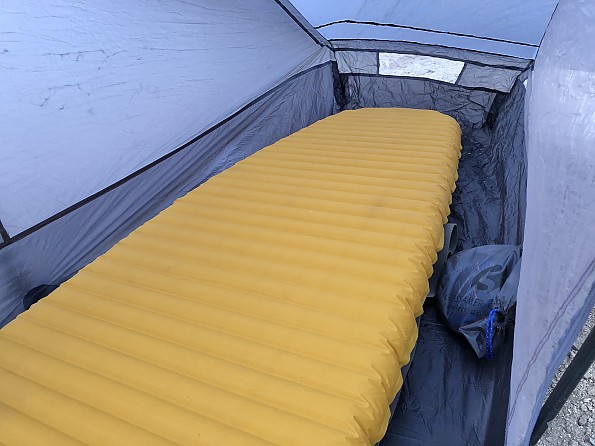
The above picture also shows the mesh vent that exists at each end of the tent.
The Gossamer The One has side pullouts at each end of the tend that I found I really needed to use in order to have an adequate amount of vertical space for my head and feet.
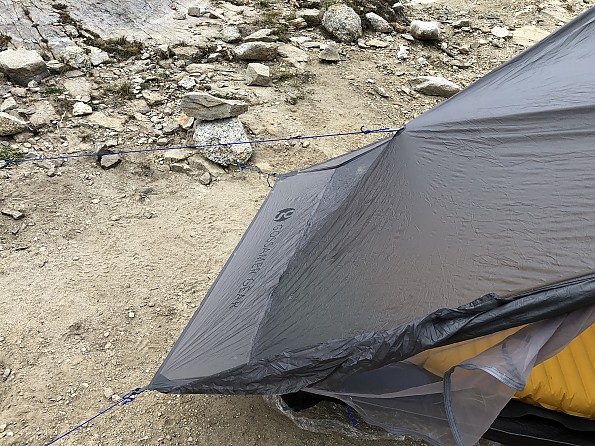

While I really like the quality of construction with 99% of the tent's design, the 1% that was just ok was with the side pull-out loop and how it was attached to the tent, which just didn’t seem very robust. The picture below is of the actual pullout.

Not enough stakes are included for the side pullouts (the newer version does have enough…), so you’ll have to add a couple of your own or use rocks for anchors like I was doing at this campsite. I should also mention that the yellowish green loops of cord you may see in some of my pictures are loops that do not come with the tent and that I had added on my own as I camp in a lot of areas where I just find it easier to use rocks that I just slip through the loops to anchor down the tent.
The vestibule is an adequate size and covers more than enough area to protect your pack and any other gear you store outside the tent.


The tent comes with an internal clothesline preinstalled at the peak of the tent which is a handy feature and there is also a single mesh pocket on the back wall of the tent for storing smaller items.
I am 5'11" and with a peak height of approximately 46 inches, I found there to be plenty of headroom when sitting up and changing clothes, etc. The door also opens all the way to the peak of the tent so getting in and out of the tent wasn’t a problem.
I didn’t experience anything more than a few sprinkles while using the tent, so I haven’t used it in any real storms. I have owned other tents made out of the same type of material, so I am sure that the Gossamer The One will perform fine if you make sure to keep it tensioned properly when you think you’re in for some heavy rain.
It’s also worth pointing out that the design of the overhangs on the tent are generous and should do a great job at preventing rain from coming in through any of the mesh vents as shown in the picture below.

My experience with condensation in the Gossamer Gear The One hasn’t been an issue yet. To be fair I have only used it on a few fair weather trips where I had the vestibule opened and stowed away, so I had the maximum amount of ventilation. I’m sure that with the vestibule fully deployed there would be significant condensation buildup like almost every other single wall tent.
Physical Characteristics of the Gossamer The One
One of the primary selling points with the Gossamer The One is weight. When I weighed the tent I found the measured weight to be right in line with the 24.5 ounces that Gossamer had advertised for my 2020 version of The One. Listed below are the actual values I measured for
- Tent weight: 22 ounces for tent and the included stuff bag
- Stakes Set: 2.4 ounces for six stakes and stuff sack
The Gossamer The One packed away in the included stuff sack with stakes is approximately 11.0 inches long by 5.5 inches in diameter, which is a nice small package. At these dimensions the tent isn’t packed tight and could be reduced in size if someone wanted to use a smaller stuff sack. I find I can easily stuff my polycryo ground cloth in with the tent and stakes without any problem.
Price
As I mention earlier, I bought this tent when it was being phased out for a newer model. I paid $209, which I think is a very fair price for a roomy one-person tent that weighs in at 24 ounces with stakes. The current model of The One is $299.25, which I still think is a fair price since the new version is about 4 ounces lighter, comes with 8 stakes and several other refinements that make an already great tent that much better.
Summary and Recommendation
Overall, I wouldn’t hesitate in recommending the Gossamer Gear The One to any solo hiker looking for a lightweight single-wall three-season tent.
Background
I used the Gossamer Gear The One on a few trips this last summer and it will be my primary tent next summer unless something else strikes my fancy. I have been backpacking since the late 1970's and have owned and used a variety of backpacking tents over the years.
Source: bought it new
Price Paid: $209
I used this shelter for my thru hikes of the Pacific Crest Trail and The Continental Divide Trail. This tent survived. I used it in snow and hail in the Sierra Nevada. Washington, Colorado, and Montana rainstorms, as well as high winds everywhere on those trails. The One never let me down.
There is a learning curve to setting this shelter up taut, but the reward is a veritable bomb shelter.
The spinnaker fabric is only noisy at first. But the material ages well, gets quieter, and never wets out or stretches in the rain.
One neat trick with this tent is to leave one half of the door open and shift the floor to the back allowing you to get a lot of ventilation yet stay dry in light rain. I also liked being able to leave the doors open in mosquito country, like the Wind River Range in July! The whole front of the tent becomes one big mesh window. It was always nice to know that at the end of every day there would come a moment when I would zip the mesh door shut and be at peace from the mozzies!
The full coverage integral fly creates a vestiblue area for wet shoes and pack. There are plenty of places to hang wet socks inside as well. This is not a free-standing tent but I found it could be set up anywhere. Sometimes by tying it out to vegetation instead of stakes or even using rock anchors.
This is a very versatile tent and it can be set up on uneven ground easily. If you are going to live in a tent for four months the Gossamer Gear One, at 17 ounces (tent body alone before seam sealing), would be a great choice.
If you are looking for something with more wind protection than a tarp but less weight than most tents this could be for you.
Another advantage of this shelter is the way it does not feel claustrophobic inside. You can set it up to be any height you wish and I tended to set it up so I could see out from under the fly.
After having used this tent for so long I would definitely say it is worth every penny.
Design: Three Season
Sleeps: 1
Ease of Setup: Somewhat Complex
Weight: 17 oz (tent body only before seam sealing)
Price Paid: $295
This shelter is outstanding! I could not be more happy with it. (Well, I could, but I'll get into that later.)
It is ultralight, provides full bug protection and wonderful weather resistance. The bathtub floor is big enough for my regular sized NeoAir mattress, and leaves plenty of room to my left for a book, my lightweight radio, and my crocs. The stitching is extremely high quality, and it was VERY easy to seam seal.
The "no-see-um" mesh is of great quality and it will clearly stand up to quite a bit of abuse. I was initially nervous about the spinnaker fabric being able to tolerate my ham-fisted nature, but after a dozen or so pitches and a couple actual bag nights, it is standing up very well.
This tent takes a couple tries to get pitched right, but once you get it, it's like riding a bike!
I have two gripes about The One...
- I am 5'11". On my NeoAir (2.5" thick) with my spring/fall quilt (Jacks R Better Hudson River) the footbox of the quilt touches the fabric of the tent wall. This is only a problem if it is particularly cold and rainy, however.
- The vestibule "beak" is pretty high off the ground, and it is difficult to get it much lower than 10 inches high. Due to the angle of the fabric and the distance involved there is no realistic chance that precipitation might enter the tent, but if it is particularly windy and cold you will have to choose your site, and pitch carefully, with the back into the wind.
These gripes are not major, however, and I am very comfortable rating this shelter somewhere between 4 and 4.5 stars, the weight/protection/ventilation ratio is outstanding, and Gossamer Gear products in general are outstanding in quality!
Design: three season, non-freestanding
Sleeps: 1
Ease of Setup: From 1 to 10, 10 being the hardest. 5.5.
Weight: 19.5oz. with six stakes, and a polycryo ground cloth.
Price Paid: $275
I just finished a 625-mile section hike of the PCT from Saddle Junction (approx mile 178) to Mount Whitney, exit Whitney Portal from May 27 to June 25. The One was the only shelter I carried the whole way.
I set it up probably about 70 to 80 percent of the time. At first I found it a little fussy to set up, but as I got more familiar with it, I got into a routine that worked well for me.
Since most of this hike was in desert or pretty dry climate the tent didn't get tested real hard in rain. I got rained on one night and a few nights of drizzle. Not a drop of water inside. On some of those misty nights in the "June Gloom" I had some minor condensation issues, but nothing that I couldn't wipe dry with a bandana or small microfibre towel.
I never did succeed in getting the backside as tight as I would like. I don't have high speed internet so haven't seen the video. Maybe that would help. (I'm waiting for the new one.)
At any rate, I always was glad that my whole shelter only weighed about a pound when I asked everyone else what they were carrying. In my opinion, lightness will cover a multitude of sins.
Only reason for not a full 5-star rating, tensioning the back and vent at the top.
Great tent, Gossamer Gear! It is easily my favorite lightweight shelter and will definitely get used on my next go at the PCT.
Chuck Shugart
Yellow Grass, Saskatchewan, Canada
Design: three season
Sleeps: 1
Ease of Setup: takes some getting used to.
Weight: 17 ounces
Price Paid: about $350 Canadian
I really like this tent. I just spent two weeks with it on the Tahoe Rim Trail and cannot say enough about the tent.
Here are my raves:
- Pitches very easy and consistently each time. Just a few minutes and it was pitched. Has a smaller footprint than some other hiking pole tents.
- Roomy. I found I had enough room in the tent to store my gear and still move around. I am 5'10". I can fully sit up and sometimes stand up bent over to move the sleeping pad.
- Ventilation. Since the tent pitches reliably each time, I found ventilation was very good. While I did not encounter any damp nights in the Sierras (a rarity), I did feel breeze coming in the tent from the bottom and top as it always pitched with about 4 inches of clearance to the ground. The slightly higher in the front vestibule contributes to what I feel is better airflow.
- Wind handling, I camped on some high ridges with nightly gusts around 40mph, had no problem with the tent standing up in those conditions.
- Lightweight. Hey 20oz total (groundcloth, tent and stakes)—what else can you ask for in a totally enclosed tent?
Cons:The spinnaker material is kind of noisy in the wind. Oh well, insert ear plugs and take to sleeping pills.
Design: Hiking Pole Tent
Sleeps: 1
Ease of Setup: Excellent
Weight: 1.25 pounds
Price Paid: $275
The One tent from Gossamer Gear met all of my expectations for a solo tent. I found it to be easy to set up, comfortable to be in, and lightweight. It has all the headroom and storage space I need, and I liked the open views and ventilation from the front.
Pros
- Lightweight
- Plenty of extra room to store belongings
- Lots of headroom
- Open views from one side
- Easy to set up
- Has a pocket for small items
- Comes with a pre-installed clothesline
Cons
- Like all single wall tents, some condensation can collect on the walls
- You must remember your trekking poles
Gossamer Gear’s The One tent is a one-person tent that hits all of my requirements in one small package. I’m picky about one-person tents, more so than with a two-person tent. Most two-person tents I’ve tested inherently feel bigger and have enough headroom, if only because they are obviously wider. One-person tents, however, can look coffin-like to me if they are very narrow and/or have a low ceiling. Like any piece of equipment, it’s a tricky balance between size, weight, features, and price.
Here’s my list of requirements: plenty of headroom, space inside to store my gear, a vestibule large enough to keep my pack and boots out of the elements, a view so I don’t feel claustrophobic. It has to be at or under three pounds (preferably under two pounds). It doesn’t have to be free-standing but the setup can’t be too fussy. It doesn’t have to have a separate fly and it doesn’t have to come with a footprint as I consider them to be optional. I jumped at the chance to test a Gossamer Gear The One tent as it appeared to meet my preferences. However, the proof is in field testing.
The One and The Two are Gossamer Gear’s one- and two-person tents, respectively. The names are very descriptive, aren’t they? The One is a non-freestanding tent that uses two trekking poles to provide structure and comes with 14 tent stakes (though it requires just six stakes at a minimum). The waterproof tent is made with silnylon fabric coated with polyurethane and has factory-sealed seams. It weighs 1 lb 13 7/8 ounces including stakes, lines, and stuff sack, but not the trekking poles.
The tent has a bathtub design, meaning that the bottom is made of thicker silnylon and that piece rises up a few inches from the ground to prevent water from seeping into the tent (see specs and materials below). There are plenty of extra loops for additional guy lines to keep the tent secure in high winds. There is an internal mesh pocket and clothes line along the ceiling. The Two looks similar but is wide enough to accommodate two people and has two doors.
Field Test
I set up the tent a couple of times in my backyard. The first time I set up a new tent, I try to do it without looking at the directions to see how intuitive it is. Then I do another round with the directions because I can almost always pick up some tips from the experts. In addition, my Gossamer Gear rep gave me a handy tip that I followed: once I got my Gossamer Gear LT trekking poles to the correct length (125 cm) for setting up the tent, I scored the metal so I could quickly twist them into place.
It was pretty easy to lay out the tent and figure out the general shape. I found a pocket on each side that accepted the top of the trekking pole and I set up the two poles first, inserting the tip into grommet tabs. There is a white circle of what looks like reinforcing material near where the grommet tie inserts into the tent which also makes it easy to visually identify the location. Then I started staking out the ties at the corners.
The only tricky part was that there are two set of tie outs at each corner and I started with the inner/lower set. It’s more efficient to stake out the outer/upper set first as they provide the basic structure. The upper set flares out a bit forming a skinny skirt of sorts, which provides ventilation for a mesh layer. The body of the tent can left hanging free but if desired, the inner corners can be staked out as well. There are ties near the trekking poles that need to be staked as well. The minimum number stakes that can be used is six.
The door is a side entry opening near one of the trekking poles. A mesh panel can be zipped to keep bugs out. A solid nylon panel zips to another panel to meet one of the tie outs to completely enclose the interior in case of rain but my assumption is that this would result in significant condensation. The only outside viewing opportunity is from the side where the entry is but the entire length of the tent can be opened up with a mesh wall. The solid panels in the front can both be rolled up and tied back. The other three sides are solid nylon panels.
I will take care to position the tent (1) into the prevailing wind for stability, as suggested by the instructions and (2) for the view from the door.
In a rainstorm, it would be relatively fast to unfurl the tent, insert the trekking poles, stake out the four corners and then the front and back. The tent would be up quickly for all intents and purposes. The gear could be protected, you could jump in the tent, and hopefully the storm would ease enough to fine tune it later.
On a backpacking trip that I was guiding, I had a group of ten, most of whom were novice backpackers. Speed was of the essence so I could get my tent set up, then assist everyone else with their gear, some of which was coming out of brand-new packaging. I was able to pop the poles in place, stake out the corners, do one more round to fine tune the stakes, blow up my pad, and toss my gear inside.
Much later, when I finally got back to the tent to go to bed (exhausted), I was really impressed with the headroom of 46 inches at the peak. I tested a tent last year that grazed my head when I sat up so I was most pleased with this aspect. With my Therm-A-Rest NeoAir X-Lite sleeping pad, I found that I had an enormous amount of room on the side and end, almost enough for another skinny pad it seemed. For those looking for a one-person tent large enough to accommodate a dog (or even a small child), this tent could work.
The zippers worked flawlessly. One minor feature that I liked a lot was the pre-installed clothesline across the top with a small clip for hanging things. This is usually the first thing I set up in a new tent so I can hang socks, my sunglasses, and other small items out of the way. I also appreciated a gear pocket for storing my phone and ditty bag. I know the little things have a weight cost, but I love the convenience.
Since it was a warm Northern California night, I left the vestibule doors open and did not experience any condensation. I positioned my tent away from the group so I had complete privacy, with a view into the woods. I didn’t get a chance to test it in wind or rain yet, so I’ll have to report back after I can get the tent out on more trips.
When I got home, I added one small item. The mesh door could be rolled up and secured with a tie, but there wasn’t one for the outer door. I added a short length of thin cord with a loop so I could secure both doors.
Summary
The One tent from Gossamer Gear met all of my expectations for a solo tent. I found it to be easy to set up, comfortable to be in, and lightweight. It has all the headroom and storage space I need, and I liked the open views and ventilation from the front.
So far, I can’t identify any downsides in terms of my requirements. However, to mention a few considerations that factor in for a tent of this type, I can say that the ultralight crowd will note that there are slightly lighter, though generally more expensive, tents out there (e.g. sub-one pound), there are free-standing, though generally heavier tents and in any single wall tent, condensation can be an issue if the doors are fully closed and it’s a moist environment. It requires trekking poles or optional poles that can be purchased from Gossamer Gear.
Specs per Gossamer Gear
- Average Weight:
- Shelter Weight: 22.4 oz / 635 g (includes factory-taped seams)
- Lines (already attached): .60 oz / 18 g
- Stuff Sack: .3 oz / 10 g
- Extra tie outs: ( 4 ) not attached .45 oz / 14 g
- 14 Stakes in stuff sack: 5.6 oz / 158 g
Dimensions:
- Packed size 6" x 9"
- Floor size 36" at the head, 24" at the foot x 88" (19.55 sq ft)
- Vestibule area 16.2 sf
- Head height at peak 46" (using 125 cm poles)
Materials:
- Tent body: Custom-formulated 7d high tenacity nylon blended sil/pu coating waterproof to at least 1200mm.
- Tent floor: Custom-formulated 10d high tenacity nylon blended sil/pu coating waterproof to at least 1200mm.
- Guylines: 2.5mm reflective nylon sheath, 1mm dyneema core
- Zippers: First quality, robust #4.5 double-pull zippers
- ITW lineloc3 tensioners on all main tie outs
Background
Lots of experience with similar tents (e.g. one-person, single walled tents that use trekking poles).
Source: tested or reviewed it for the manufacturer (Kept it)
Your Review
Where to Buy
You May Like
Specs
| Price |
MSRP: $255.00 Current Retail: $255.00 Reviewers Paid: $175.00-$295.00 |
| Shelter Weight |
17.7 oz / 503 g (includes factory-taped seams and lines attached) |
| Tent Stuff Sack |
9.7 g |
| Clothesline |
5.8 g |
| Stake Stuff Sack |
4 g |
| Aluminum Stakes (8) |
11 g each |
| Extra cord (2) |
7 g each |










